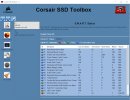I was given a Corsair Force GS 240 Gb SSD as a gift some years ago. It sat in a box until I put together this desktop and used it as the C: drive. From almost the beginning, the S.M.A.R.T. status on the Bios said that it was going bad. The Corsair SSD Toolbox is saying the same thing.
My question is, how does S.M.A.R.T. determine the life of an SSD? Is it the actual hours plugged in (apparently ~3,500 hours), or from the date of manufacture? According to the Serial #, this was built in August of 2016. So, 7 years old now.

My question is, how does S.M.A.R.T. determine the life of an SSD? Is it the actual hours plugged in (apparently ~3,500 hours), or from the date of manufacture? According to the Serial #, this was built in August of 2016. So, 7 years old now.
